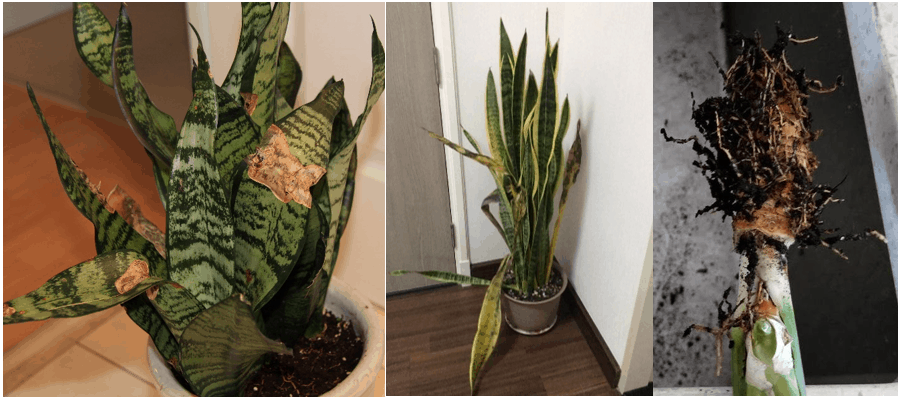How to Grow and Take Care of a Snake Plant: The Ultimate Guide
The snake plant, also known as Sansevieria or Dracaena Trifasciata, is one of the most popular and hardy species of houseplants. It doesn't matter if you keep them indoors or outdoors on your balcony or in your garden; these spiky beauties can match up with almost anything you put near it.
As you might know, there are countless health benefits of having snake plants in your home. Some of them are mentioned below:
- They filter out harmful pollutants
- Snake plants are effective against allergies
- They thrive in low light and are easy to care for
- They produce Oxygens even at night
- They provide mental calmness
Snake plant is easy to grow, but you should know a few things before you start growing them. Here are the steps to take care of these plants.

What Kind of Soil Is Good for Snake Plants?
Even though snake plants require little maintenance, if the base or foundation they grow is mixed incorrectly, they can suffer various serious issues.
Snake plants require light soil that provides good aeration in roots, reducing compaction. Few soil characteristics as are necessary for growing snake plants are mentioned below:
- A snake plant is native to tropical Africa, where the environment is dry and rocky. Therefore, they require soil that drains quickly.
- Snake plants cannot grow when soil is compact as they are unable to breathe and function properly. Another problem is soil that does not allow for proper aeration, hindering plant growth.
- It is essential to fulfilling the snake plant's nutritional requirements. So, make sure the soil is nutrients rich.
- Snake plants benefit from warm soil because it helps them absorb nutrients and water. Soil temperatures between 60-75 degrees F are ideal for them.
- In terms of acidity, the preferred pH range for snake plants is between 5.5 and 7.5, but they can also grow in a pH range between 4.5 and 8.5.
How To Make Snake Plants Grow Faster?
It is relatively easy to grow a snake plant and nearly impossible to kill. However, they grow at a slower rate, compared to direct sunlight, in an indoor environment. Some important things you should make sure of to make your snake plants grow faster are mentioned below:
- Propagating Snake Plants can help them grow faster. After cutting a healthy leaf, you can fully root the plant in water or soil with no water and then plant it. It can be beneficial to cut the leaf into multiple divisions and grow them in separate pots.
- As mentioned earlier, choosing good quality soil is essential in making the plant grow faster. Succulent plants are vulnerable to rotting roots, so using a mix of well-draining soil for the snake plant is vital.
- Using the right pot is necessary for the healthy growth of Snake plants. In terms of size, an 8–12-inch pot would be the best for these plants. Furthermore, in terms of the types of pot, Terra Cotta pot works best for snake plants because it helps the soil dry quicker than plastic pots.
- The plant will bloom faster and better if you keep it slightly root-bound. This will also support the development of young offshoots.
- During periods of high stress, Snake plants can benefit from the use of fertilizers. In general, NPK fertilizers with a ratio of 10-10-10 are the best, although other ratios may also be suitable.
- The growth of Snake Plants is enhanced by bright or well-lit indirect lighting. Sheep plants thrive in bright light.
- Make sure only to hydrate the plant when the soil surface is dry. Gently stick your finger or a chopstick into the soil. If you feel any moisture, do not water.
Taking Care of Snake Plants
Many aspects can contribute to the healthy growth of Snake Plants. Here are a few ways of taking care of Snake Plants.
How to Repot a Snake Plant?
Snake plants may need to be replanted if water does not penetrate the soil and stays at the top. Occasionally the soil can become crusty and resist wetting.
Materials Required for Repotting
- Best type of soil: The most straightforward way to create a soil mix is to mix equal parts garden soil, coco peat, and compost. There are potting mixes readily available in the market for those with busy schedules or if it is hard to collect and mix ingredients for pot mix.
- Right-sized pot: It's best to measure the previously used pot and buy a new container that is more than two-inch wider than the old one.
- Scissors or Knives: If the roots are too long, these items may be helpful to cut them off.
- Wearing gloves protects your nails and hands.
- Trowel: You can probably use a trowel to dig the pot or remove the plant with it.
- A watering can and spray bottle.
Repotting the Plants
The best way to repot snake plants is to follow these steps.
- Choose a larger pot, as mentioned previously.
- Soak the New Pot in Water.
- Make a drainage hole in the pot to let the excess water drain. To prevent soil from washing out through the drainage hole, cover the hole.
- Remove the plant from the old pot. It would be best if you moisten the soil first, as moist soil is easier to remove from the container.
- In the center, place the plant upright, press firmly, and add soil at the top. Water well afterward.
How Do You maintain an Overwatered Snake Plant?
If Snake Plants have been overwatered, check the leaves and roots and dry them immediately. Afterward, fertilize, and propagate them if necessary. Keeping a snake plant overwatered for too long can cause root rot.

How do you fix and prevent leaves from curling?
Some ways of maintaining snake plant leaves from curling are mentioned below:
- Your snake plant does not require much water, but you must maintain a regular watering schedule to keep it moist. This helps the leaves spread evenly without tangling. Water your snake plant every 2-4 weeks to keep it healthy.
- In contrast, overwatering can also cause curling. If Snake Plants have been overwatered, check the leaves and roots and dry them immediately.
- Adequate sunlight is necessary. Snake plant needs at least 7-8 hours of indirect sunlight each day.
- Low humidity and improper temperature should be avoided. You should keep your snake plant at a temperature between 50 and 85°F (10 and 29°C) and about 40-50% humidity.
- Plants should be repotted every 1-2 years, depending on how fast they grow.
- Pests can easily cause your spider plant to curl and lose its upright position. They can also result in stunted growth caused by viruses carried by pests. You can use pesticides to prevent it.
Root Rot in Snake Plants
Fungus infestation or overwatering can cause root rot in Snake Plants. Root rot can cause unusual drooping and stalled growth of the plant. Furthermore, the soil with rotted roots can emit a foul smell.
Snake Plant root rot is treated by inspecting for root rot damages, pruning the affected parts as soon as possible, sterilizing the roots, then repotting in healthy fresh soil.
If fungus infestation occurs in your pot, using a spray of cinnamon, Neem Oil, diluted Hydrogen Peroxide, or commercial fungicide can be a suitable prevention method.
Why and how do you prune Snake Plants?
Pruning is an essential process of growing a plant. Pruning Snake Plant can help:
- Maintain The Size of Your Snake Plant
- To Remove Damaged or Old Foliage
- To Improve the Shape of Your Plant
After managing a sharp knife, pruners, scissors, a sterilizing agent (boiling water or alcohol) for the tools, and a clean surface with enough space to prune the plant, you can start pruning your Snake plants.
- Reduce the spread of the plant by cutting the edge horizontally upwards of the Snake plants.
- To reduce The Height of Your Snake Plant, cut each leaf separately until you get the preferred height.
- As soon as you have trimmed down your snake plant to the correct size, inspect the leaves for damage or deformity. Remove the damaged leaves afterward. Make sure the plant does not stand lopsided.
If you prune it back by one-third or less, the snake plant will need to be pruned again within 2-3 years. Snake plants grow slowly, depending on the conditions you are growing them in.
Finally, I hope that after you've followed these methods, your Snake plant becomes as healthy as it can. Keep it near you and enjoy all of its benefits.

